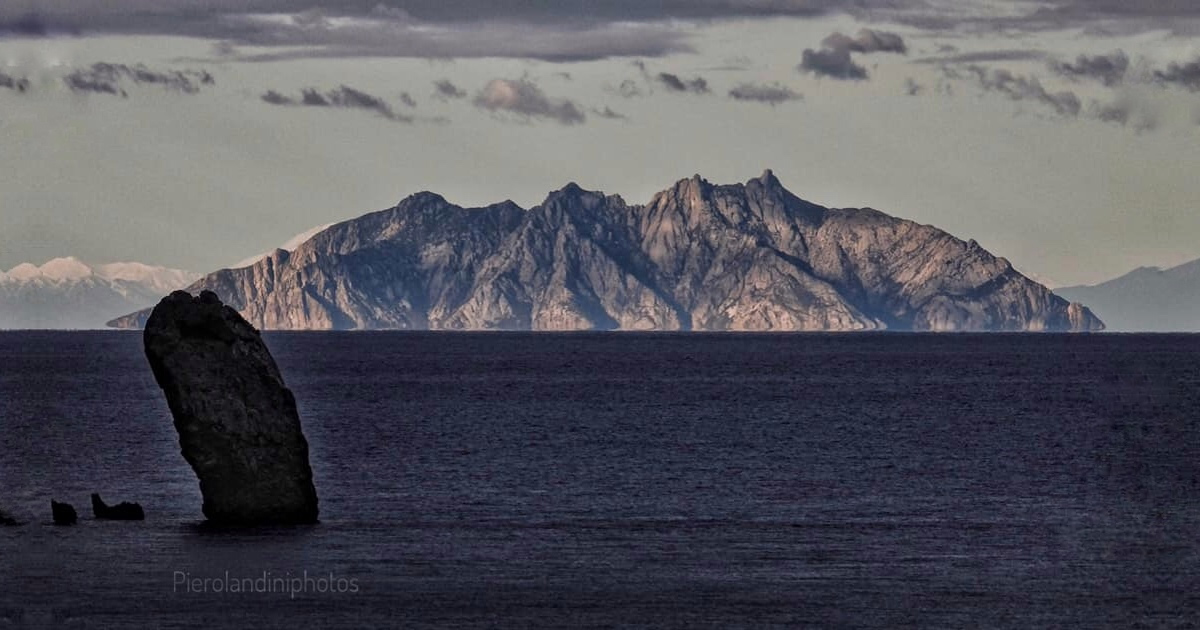While news channels all over the world were reporting the devastating disaster of the Costa Concordia shipwreck off the coast of Giglio, another tragedy was quietly unfolding a few kilometers away on the island of Montecristo. Considered the heart of the Tuscan Archipelago, Montecristo, a Biogenetic Nature Reserve of the Italian State, is one of the most protected and inaccessible places in the Mediterranean. Consisting of a giant granite mass that rises from the sea up to an elevation of 645 meters, it is characterized by steeply sloping rock faces that plunge down into the once pristine sea. To avoid disturbing this fragile ecosystem, visitors must ask to join one of the rare summer excursions on the Cala Maestra. Only a few researchers can obtain special permission to visit the island without constraints. It was in this once pristine environment that in 2012 the Park Authority decided to carry out the "Life-Montecristo 2010" project, financed with about 1.6 million euros, by dispersing via helicopter, over the entire surface of the island, more than 14 tons of bait containing "brodifacoum" (Annex 1), a poison known to be persistent in the environment and highly toxic even to aquatic organisms. Their idea was to eradicate the black rat, which has been present on Montecristo since Roman times, with the aim of protecting a single species of seabird, the shearwater, regardless of the disastrous effects the intervention would have on the ecosystem.
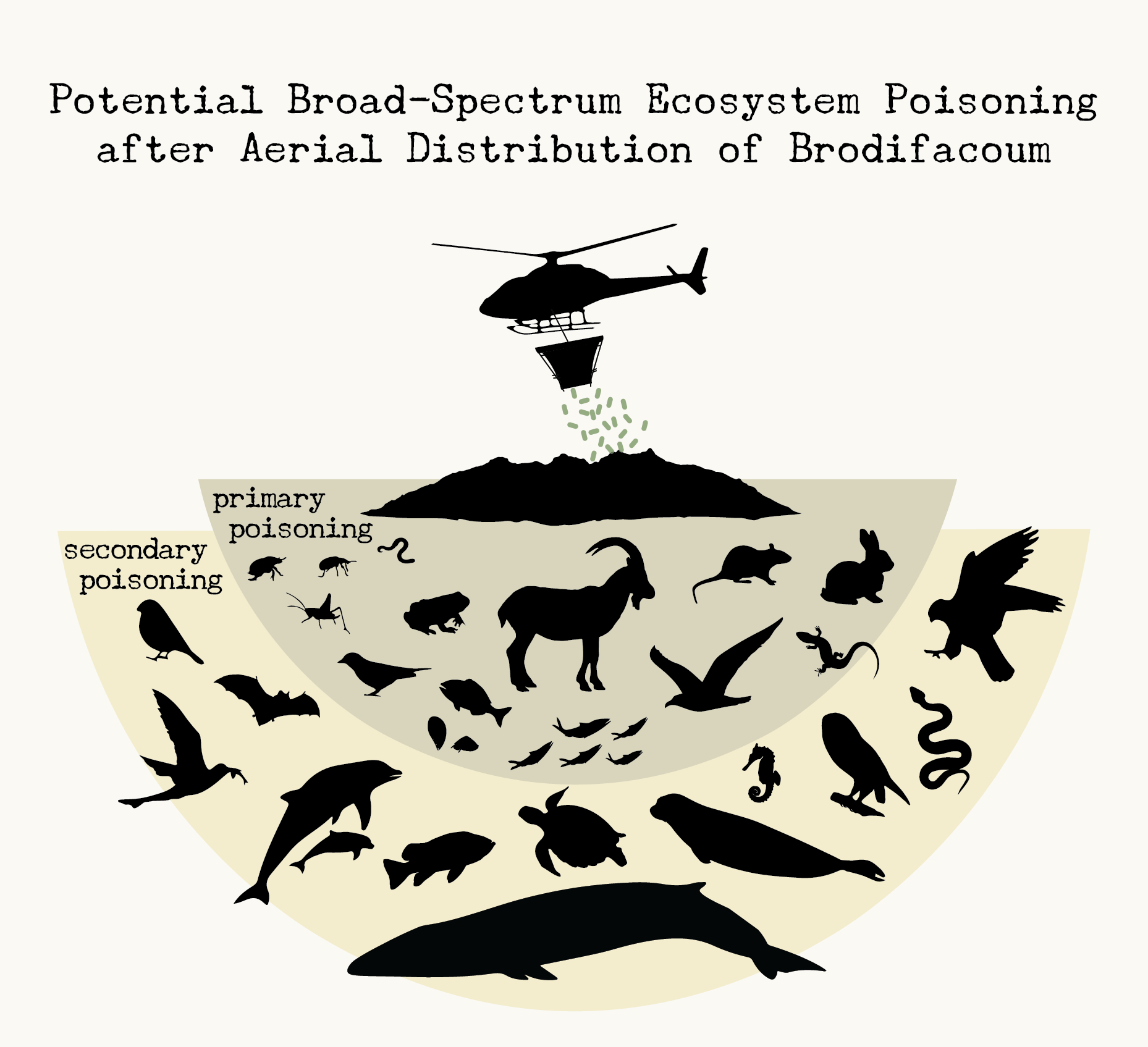
EXPERTS ARE CALLING IT AN ECOLOGICAL DISASTER
Independent scientists and experts in the field of island fauna describe the effect of such a massive quantity of 'brodifacoum' released into the environment as an 'ecological disaster'. This active ingredient is in fact a potent anticoagulant which, because it is not species-specific, is responsible for the primary and secondary poisoning of a very wide range of species, as the substance enters the food chain through countless channels and remains there indefinitely. Primary poisoning occurs when an animal eats the poison directly (such as Goats, Rabbits, Herring Gulls, Eastern Partridges, Granivorous Birds, Lizards, Fish...); secondary poisoning occurs instead when a predator or a "scavenger" feeds on a prey that has ingested the poison (this happens with nocturnal and diurnal birds of prey, Corsican Gulls, Crows, snakes, birds that feed on insects, amphibians such as the Sardinian Discoglossus, bats ...). The primary and secondary poisoning, may result in a long and agonizing death, as the substance causes internal bleeding and dehydration which precede the death. With this poison there is also bioaccumulation in the environment. For instance, some species of fishes may consume "brodifacoum" at a sub-lethal dose and store the toxin in the liver. If a larger predator, such as a dolphin or stenella, eats several fish or crustaceans containing small amounts of "brodifacoum", the poison will accumulate in their system and may reach a level that causes death. Recent studies show that residues of "brodifacoum" can remain in fish for up to three years after ingestion. Given the steep slopes of Montecristo and the presence of numerous "wrinkles" and ditches, in addition to the poison that ended up directly in the sea following the launch from the helicopter, numerous tons of it must have flowed there after the first heavy storms, which came almost a year after the last launch. About a month after these first rains, in the first months of 2013, an unusual number of cetacean beachings were described on the coasts north and east of Montecristo. Results of investigations into the cause of death of these marine animals have been inconclusive, although environmental contaminants have been listed as a possible contributing cause of their deaths.
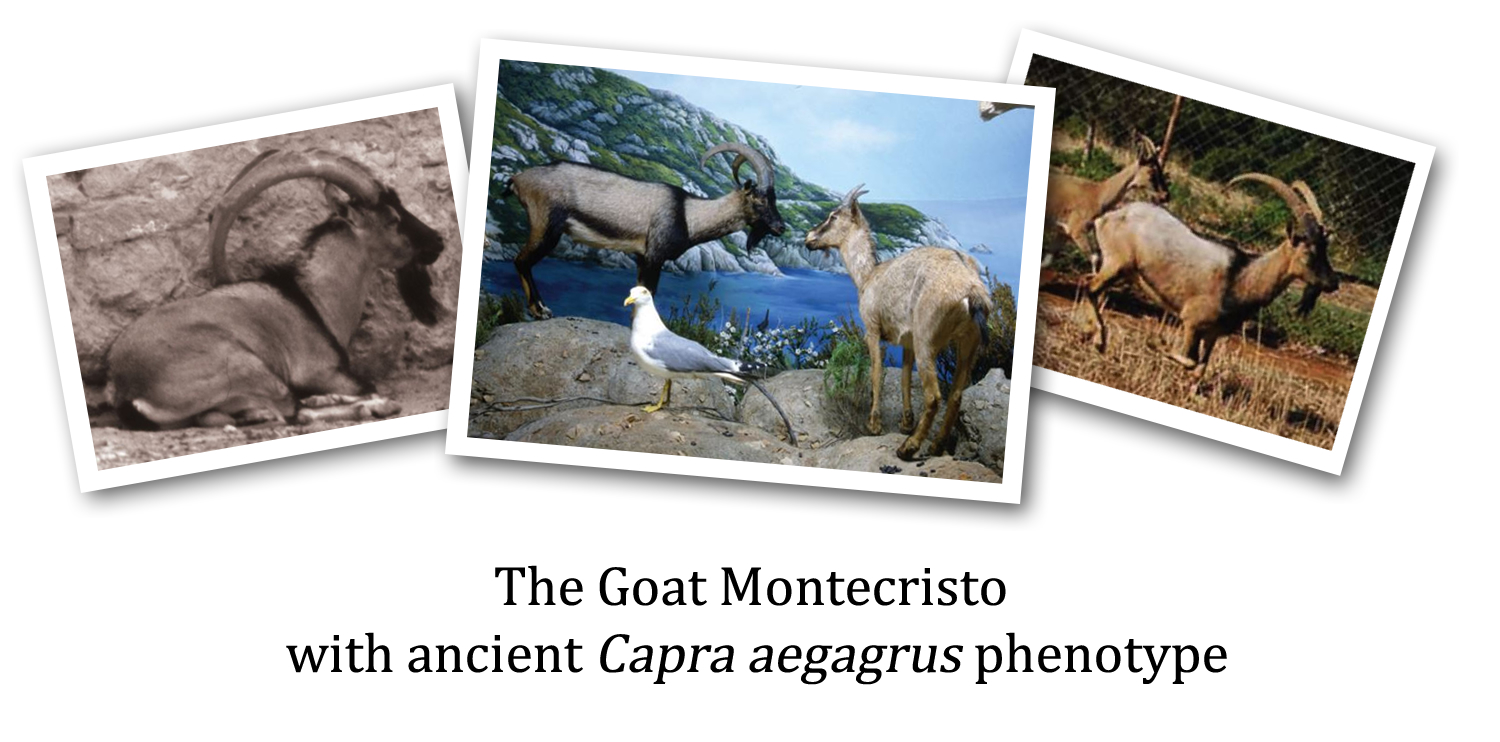
DOES THE AEGAGRUS GOAT OF MONTECRISTO STILL EXIST?
The goat population of Montecristo was constituted, before the implementation of the "Life - Montecristo 2010" project, by 30% of individuals belonging to the phenotype Capra aegagrus, the Near Eastern goat, and other types of goats introduced in recent times (domestic goats of the ancient Corsican breed). The wild goat, Capra aegagrus, gave its name to the Aegadian Islands, the Aegean Sea, and the Island of Giglio (Aeghilion). The Goat of Montecristo was the only existing population of wild goats in Italy. As we learn from an article published in the journal Mammalia in 2015, Prof. Marco Masseti, an expert on island faunas, documents how the population of wild goat, Capra aegagrus (Erxleben 1777), present on Montecristo Island since the Neolithic period, has been "drastically reduced, if not almost completely eliminated following the implementation of the EEC LIFE+ Montecristo 2010 Project". After the dispersion of the pellets poisoned during this "Life" project, in fact, the ancient population of Capra aegagrus has practically disappeared from the island. After this "ecological disaster" the Park Authority also organized a large and extravagant event, placing five of the surviving goats still present on Montecristo in the BioPark of Rome. None of those specimens had the phenotype of the ancient Capra aegagrus, the Near Eastern egagro. It is likely the last specimens of the ancient goat on Montecristo all fell victim to the "brodifacoum". This fact is confirmed by genetic analysis of the goats present on Montecristo after the widespread poisoning carried out by the Park Authority and coadjutors. In this study, performed in 2014, the genome of the goats still present on the island - derived from the 43 goats secured in a fenced area during the poisoning - was compared with the Montecristo goats, of the egagro phenotype, which about 10 years earlier - fortunately - had been secured in some small fenced pastures on mainland Italy, between Tuscany and Liguria, by some enthusiastic private breeders. These genetic analyses have revealed that the Capra aegagrus specimens present ex situ, possess 27 alleles that are no longer found in the genotypes of the island population, confirming that the original wild goats have been eradicated from Montecristo.
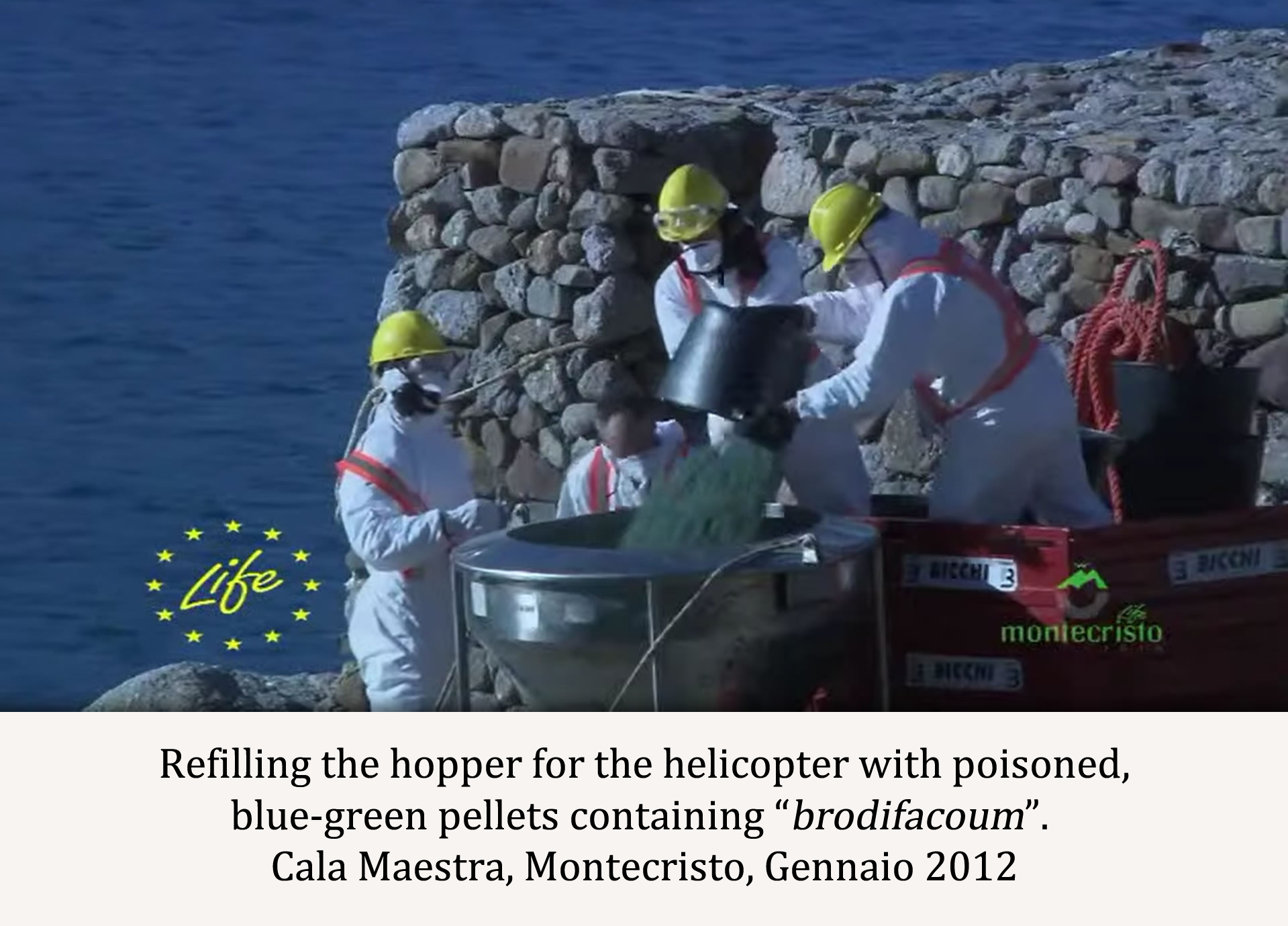
FROM THE PARLIAMENTARY COMPLAINT TO THE COURT OF LAW
Carlo Gasparri, a citizen of Elba, a great sportsman and a profound connoisseur and lover of the sea, a former world champion of underwater fishing, as soon as he learned of the project that was being carried out on Montecristo, denounced the Park Authority to the Public Prosecutor's Office. Carlo Gasparri approached the island after the intervention of the Park Authority, on a boat of the State Forestry Corps, and witnessed what he describes as "a sea of dead seagulls on a silent and inanimate island". Following this complaint, on February 15, 2012, Senator Lucio Barani, presented to the Ministry of Health and the Ministry of Environment and Protection of Land and Sea, the question No. 4/14926, exposing all the violations of the law committed by the Park Authority and coadjutors and the serious consequences in terms of damage to wildlife and environment both land and water, which would result. The Minister of Health, Renato Balduzzi - unfortunately too late - requested a technical-scientific opinion from the National Reference Centre for Veterinary Forensic Medicine established at the Experimental Zooprophylactic Institute of the Lazio and Tuscany Regions. In this opinion, it is specified that:
“the "brodifacoum" appears to be, on the basis of the most recent scientific literature available on the subject, of significant environmental persistence. Because of the poor degradability of this molecule in the environment, after its dispersion both through special containers and by air, numerous cases of primary and secondary poisoning are known to occur in a large number of animal species, including non- target species, including mammals, birds, invertebrates and reptiles (...). There is an extensive bibliography on the environmental persistence of brodifacoum (...) dating back to the 1990s.”
The same technical-scientific opinion goes on to point out that once “brodifacoum is dispersed in the environment, it 'remains there for a long time and enters the food chain through a large number of ways that are only partly known at present, for example through the invertebrates that feed on the baits, the residues of unused pellets, the feces of animals that have ingested brodifacoum, even at sub-lethal doses, or the remains of organs of animals that have died of poisoning (...)'. The damage caused to the environment also extends to the subsoil, as highlighted in the same report: "Experimental exposure to 500 ppm of brodifacoum mixed with soil caused the death of 85% of specimens of grey earthworms (Apporrectodea caliginosa) 28 days after the start of the experiment".
On the basis of this scientific opinion, which described the "ecological disaster" that had already occurred on the island of Montecristo, the Ministry of Health sent all the relevant documentation to the Public Prosecutor's Office of Livorno.
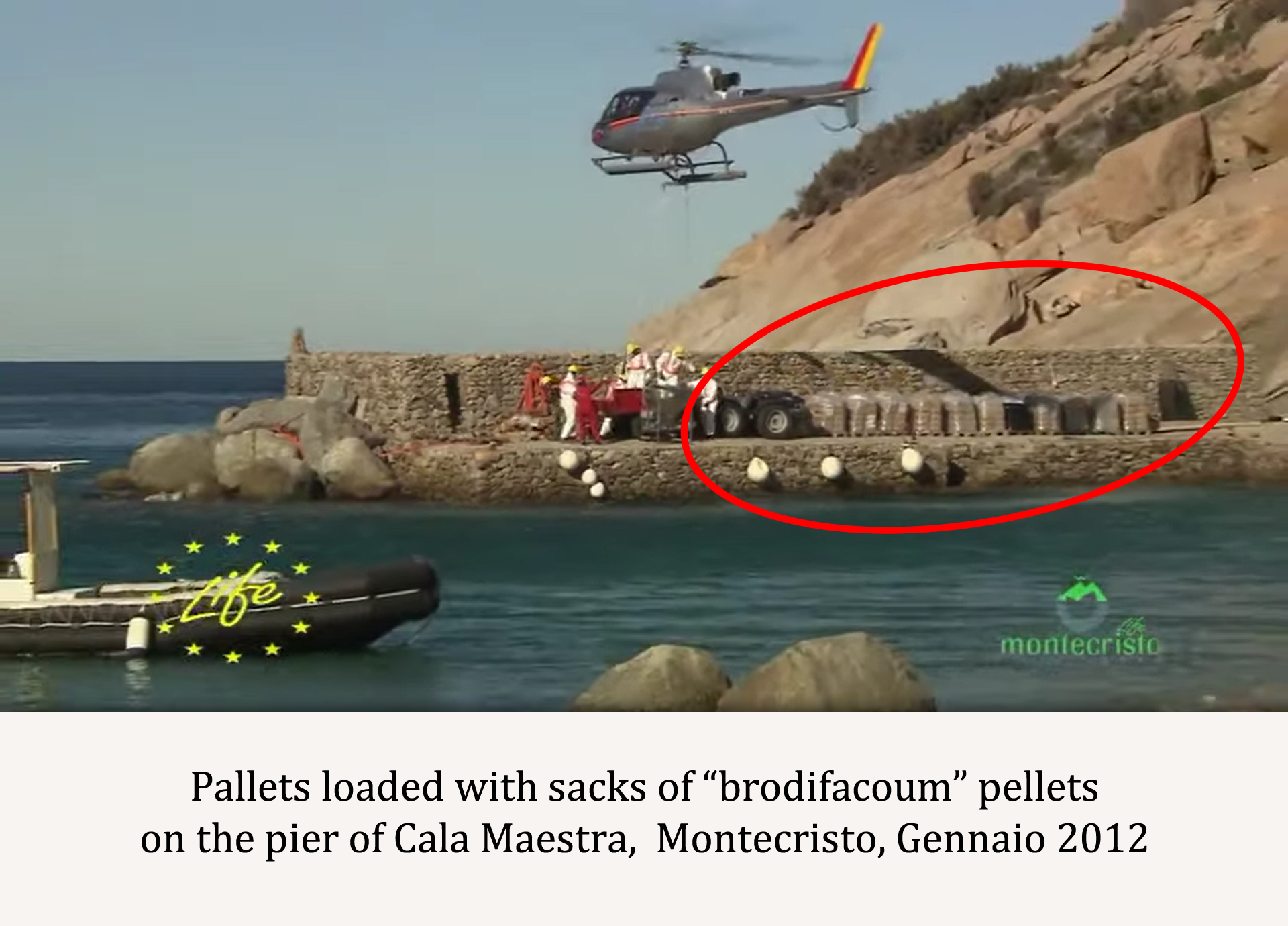
INTERVENTION OF THE MAGISTRY - JUDGMENT OF THE JURIST OF LIVORNO N.39/14 OF 21/01/2014
The indictment against Stefano VAGNILUCA - Head of the Territorial Office for Biodiversity of Follonica, Franca ZANICHELLI - Director of the Tuscan Archipelago National Park, Vincenzo GRIMALDI - Commissioner of ISPRA, Paolo SPOSIMO - of NEMO srl, concerns articles 110 and 650 of the criminal code, respectively "concurrence of more than one person to the crime" and "failure to comply with the provisions of the Authority"; this generic charge, which has no relevance with regard to the serious damage caused to the environment both on land and at sea, as described above, allowed the defendants to resort to oblation, paying the pecuniary penalty provided, without the Judge being able to express any opinion on the facts objectively contested. Therefore, the G.I.P. declared that there was no need to proceed against the same defendants, only because the crime ascribed to them was extinguished due to oblation. This made it possible for no judicial investigation to be carried out in the trial described, but the acts attached to said proceedings (including all those stated in this document) clearly attest to the seriousness of the crime and the conduct of the defendants who, by paying the oblation, did not contest them and recognized them as existing. The inertia on the part of the judicial system, as described above, then gave the park authority and the other parties involved the opportunity to repeat this intervention on other island realities. In addition, we wonder why autonomous institutions that should be responsible for the control and protection of the environment, were then included as beneficiaries of large funding, thus probably losing the autonomy that is essential for those who intend and have the obligation to perform such an important task of supervision, control and protection.
RAT ERADICATIONS ARE DOOMED TO FAIL - THE RAT RETURNS
After the numerous tons of "brodifacoum" dispersed on the island and the countless number of animals that fell victim to this action, no scientific evidence supports a positive outcome of the attempt to eradicate the rat from Montecristo. NEMO s.r.l, one of the beneficiaries of the project, contributed to the reintroduction of the rat in 2016, during a bait container efficiency test in which 2 of 14 radio-collared rats were lost on Montecristo. Additionally with the recent shipwreck of the fishing vessel Bora Bora off the coast of Montecristo in the summer of 2019, new rats may have been introduced adding to the remaining rat population still on the island. It should be noted that in such an attempt to eradicate rats, all of their natural predators such as barn owls and other birds of prey are also killed; thus, the island will be deprived of the natural predators essential for the natural containment of rodents.
CONFLICT OF INTEREST AND LACK OF ADEQUATE PRELIMINARY RESEARCH
In the application for approval of the 'Life - Montecristo 2010' project, the director of the park at the time, Franca Zanichelli, stated that, 'since this is an intervention directly connected with and necessary for the management of the site, it is not subject to an impact assessment procedure'. This statement denotes the absence of an in-depth study of what the rat eradication operation would entail in terms of environmental impact on the entire terrestrial and marine ecosystem.
In the black rat eradication plan, Francesca Giannini (Tuscan Archipelago National Park) states that:
"during the aerial distribution of the baits, despite various devices that allow to direct the launch of the material, it is difficult to avoid that some product ends up in the sea. Montecristo has an extremely steep coastline; this morphology in fact favors the possibility of the bait falling in the water by simply rolling. The active ingredient is not soluble in water, but it cannot be excluded that the product is ingested by fish at the time of the fall and therefore there is a risk of poisoning fish through direct ingestion."
Giannini reports the results of a test carried out to determine the risk of 'brodifacoum' being ingested by fish. The results showed that 9 out of 28 species of fish observed showed attraction to the bait (bream, bream, peacock thrushes, damselfish, peacock damselfish, scribe and cabrilla sharks, salps, and green wrasse), with two species repeatedly eating the bait (salps and damselfish). Her concluding remarks on the experiment were as follows:
"the damselfish and the salpa appear to be the species most attracted to the baits in terms of both frequency and intensity of eating (both species appear to ingest the bait) (...) it is noted, however, that the two species are extremely common and not listed as protected species by international conventions or directives."
Independent scientists and experts in marine biology are surprised by the lack of consideration for the possible entry of "brodifacoum" into the marine food chain with the possibility of poisoning a whole range of species, from small crustaceans to cetaceans such as dolphins and fin whales. They were therefore aware that the poison would enter the sea and that fish would ingest it, thus contaminating the "International Cetacean Sanctuary".
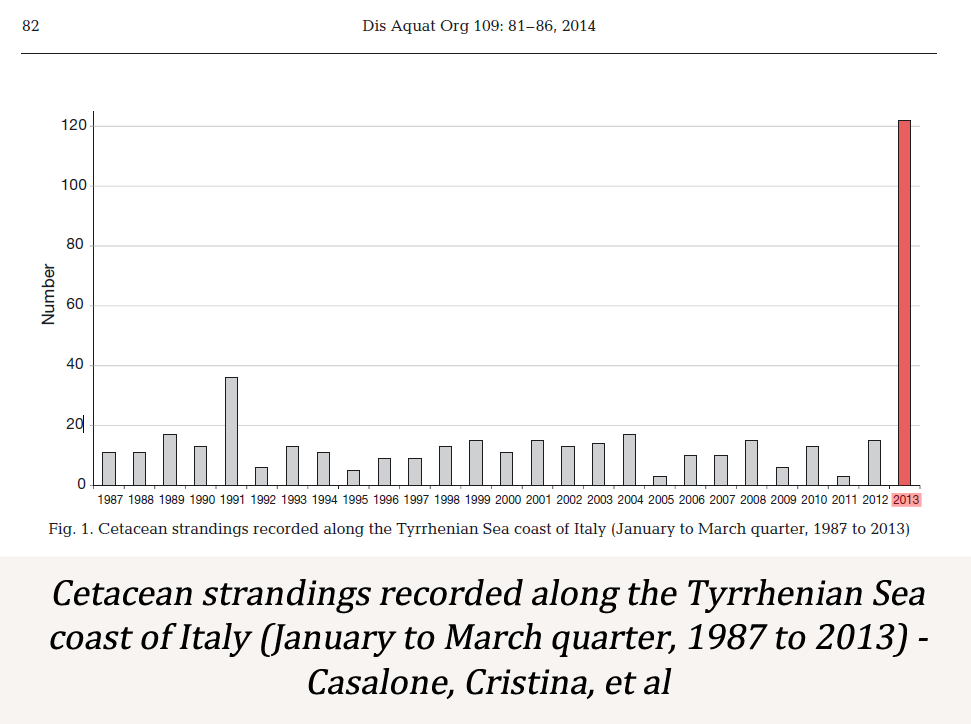
The 14 tons of pellets containing brodifacoum were distributed on Montecristo in January 2012. The first heavy rains occurred after about 10 months. The abnormal spike in cetacean deaths corresponds precisely to the months following the first heavy rains.
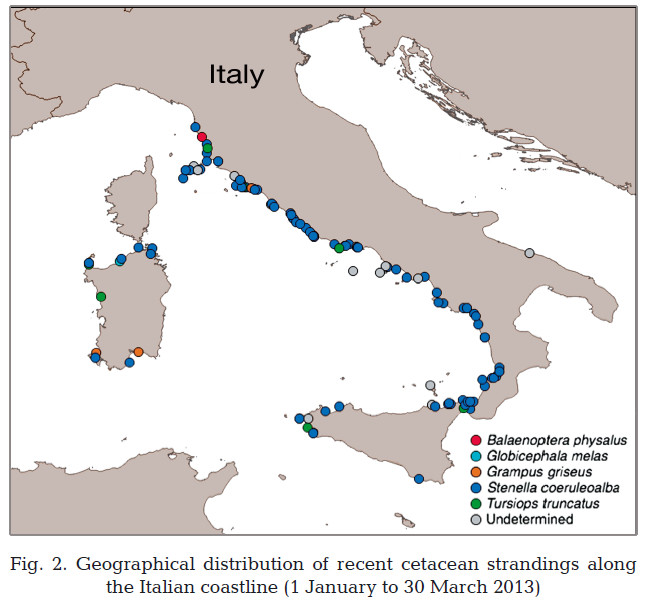
Geographic distribution of cetacean beachings along the Italian coastline (1 January to 30 March 2013), Casalone, Cristina, et al
"PRIMUM, NON NOCERE": FIRST, DO NO HARM - THIS SHOULD BE THE PRINCIPLE TO BE FOLLOWED
While the story of Monte Cristo has gone somewhat unheard, it is our hope that this article will not fall on deaf ears. While we cannot change the past, we have a responsibility to learn from it. On the Island of Giglio, the Park Authority and some of the same beneficiaries of the project "Life-Montecristo 2010", are proceeding to exterminate our Mouflons and to cover the ice plant with black, plastic tarps. The "Letsgo Giglio" project remained a secret until a few months ago, when the disturbing details of its actions were revealed. After our community communicated its concerns, the Park Authority led us to believe that the Mouflons would be transferred to large reserves on the mainland when, instead, only three were locked up in the small Maremma Wild Animal Recovery Center, where they will live in captivity after being sterilized. Not having preliminarily investigated the origin of the nucleus of these Giglio Mouflons, the promoters of the “LetsGo Giglio” project are unable to assess their genetic and phenotypic importance. This nucleus was in fact constituted in 1955 by Ugo Baldacci, thanks to the interest of some of the most important Italian zoologists of the time, Augusto Toschi, Alessandro Ghigi and Renzo Videsott, in an attempt to avert the extinction of the species in Sardinia and Corsica. In the meantime, the Park Authority has held a training course to recruit volunteers in anticipation of the collective culling of the Mouflons scheduled for the 15th of September. Many people and experts are opposed to the "LetsGo Giglio" project and almost 5,000 signatures have been collected in a petition to stop the extermination of the Mouflons on Giglio Island. Every project carried out by the Park Authority becomes a pretext to carry out similar interventions in the future, so that ecological disasters such as that of Montecristo can be repeated. This policy of indiscriminately poisoning the islands and seas, in defiance of the basic principles of ecology, is unacceptable. In medicine, there is a Latin saying, attributed to the Greek physician Hippocrates: "Primum, non nocere": “First, do no harm.” This should be the principle to be followed.
We thank Piero Landini for the cover photo.
The documents intended for the authorities were requested from the offices that held them in accordance with the regulations in force.
Cesare Scarfo’ for SaveGiglio
